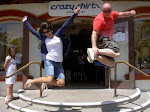I really liked reading chapter 6 because it was of a lot of ideas of practical application in the classroom. I really liked the strategies it talked about for important, focused, and engaging curriculum. My favorite ones were using meaningful audiences, and help students discover how ideas and skills are useful in the world. It would be so much easier to get our students excited about things that are meaningful to their life, and they see a purpose behind! It makes my job easier in a way, why would I not want to do that? I do think that it is important that we incorporate these principles, but continue to make sure that the curriculum is demanding and we have high expectations for our students.
I loved where it talked about using small group instruction as a regular part of instruction cycle. What a great idea I never would have thought of. And the beauty of it is that it doesn't take much planning. I can look for needs in the classroom that need to be met, ask students who need help with that concept to meet with me in the back of the classroom and ten minutes later those students walk away with a clearer understanding. It is a great way to access your students and as a teacher evaluate what needs to be re-taught in a different way.
I also like the idea of establishing peer networks for learning. When I read this I immediately thought of two things. First I thought of how holding morning meetings in our classrooms can create a community of learners and peer networks will already be in place if our classroom is already operating in that way. Secondly I thought of our cohort and how we totally operate in peer learning groups. I think because we learn using peer learning groups, that is what makes learning so enjoyable for us! I really do enjoy coming to school now because it is easier for me since I have a whole network of other students that I can learn together with. Establishing peer learning groups in my own classroom will be a huge goal of mine because I believe it will make the biggest difference between having a successful or non-successful school year.
